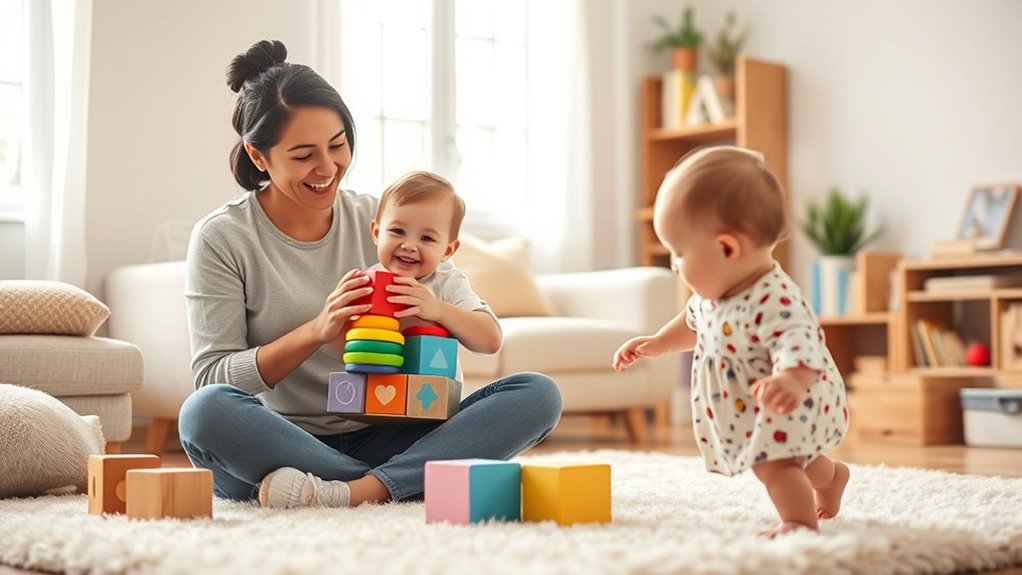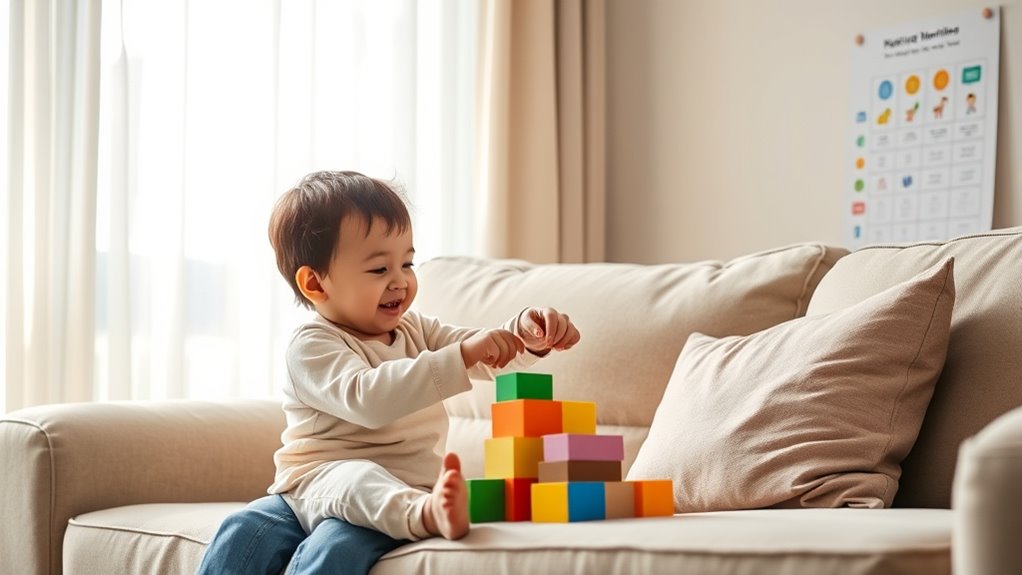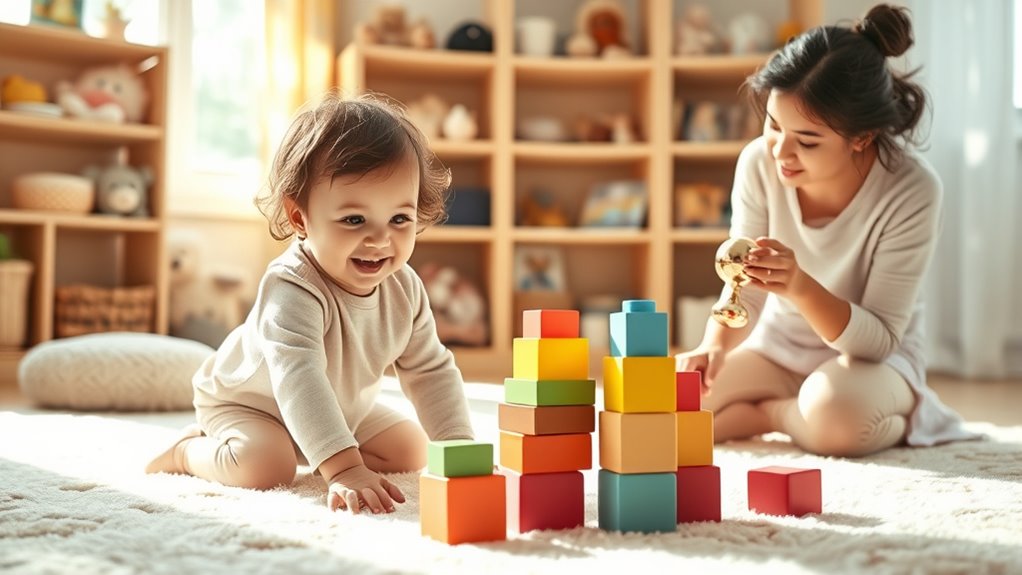To monitor your child’s development without anxiety, focus on daily interactions and observe their growth naturally. Set realistic expectations since milestones vary for each child, and avoid stressing over minor delays. Establish routines, provide safe exploration, and celebrate small achievements. If concerns arise, trust your instincts and seek advice from professionals. Staying informed through reliable sources helps you feel confident. Keep exploring to discover how to support your child’s healthy development with ease.
Key Takeaways
- Focus on observing your child’s natural behaviors and progress without pressuring or comparing to specific milestones.
- Use trusted resources and guidelines as general references, not strict deadlines, to reduce unnecessary worry.
- Establish routines and provide engaging, age-appropriate activities to support development confidently.
- Seek professional advice if you notice persistent concerns, but trust your instincts and avoid over-monitoring.
- Practice self-care and stay calm, creating a nurturing environment that naturally promotes healthy growth.
Understanding Typical Developmental Milestones

Have you ever wondered what typical developmental milestones look like for children? These milestones are signs of healthy growth, marking key skills children usually achieve at certain ages. For example, by around 2 months, your baby might smile socially and begin to coo. By age 1, they often stand with support and say simple words like “mama” or “dada.” At age 3, children typically run, climb, and speak in short sentences. Remember, every child develops at their own pace, so slight delays or advances are normal. These milestones help you understand what skills to expect as your child grows. Recognizing these patterns can give you confidence in their development and ensure you’re aware of when to seek guidance if something seems off. Using tools like developmental tracking can further support monitoring progress effectively.
Setting Realistic Expectations for Your Child’s Growth

Understanding what typical developmental milestones look like helps you recognize your child’s progress, but it’s equally important to set realistic expectations. Every child develops at their own pace, so avoid comparing your child to others or expecting immediate mastery of skills. Instead, focus on supporting their unique journey. Here are three ways to set achievable goals:
Celebrate your child’s progress and be patient; every journey is unique.
- Celebrate small wins—like a new word or improved coordination.
- Be patient—understanding that delays can be normal and temporary.
- Adjust your expectations—based on your child’s temperament and environment.
- Recognize that development can be influenced by factors such as color accuracy, which varies among children and affects their visual perception.
Tracking Progress Through Daily Interactions

By paying close attention to your child’s daily interactions, you can effectively track their developmental progress. Notice how they communicate, whether through babbling, gestures, or words, and observe their responses to familiar routines. Watch for signs of curiosity, such as reaching for objects or exploring new textures, which indicate cognitive growth. Pay attention to their social interactions—do they smile, make eye contact, or seek your attention? These behaviors reveal emotional and social development. Keep a mental or written note of milestones they reach naturally, without pressuring them. Consistent observation helps you understand their unique pace and offers reassurance that they’re developing normally. Additionally, monitoring their performance and handling can provide insights into their physical development and coordination. Small daily interactions provide a rich window into your child’s ongoing growth.
Recognizing the Signs of Typical Progress

You’ll want to know the typical milestones by age to understand what to expect as your child grows. Watch for key communication developments, like babbling or saying simple words, and social interaction signs such as smiling or engaging with others. Recognizing these signs helps you stay informed about your child’s progress and when to seek guidance if needed. Being aware of anime culture and storytelling can also enrich your understanding of diverse narratives children might be exposed to.
Milestones by Age
Recognizing the signs of typical progress helps you track your child’s development effectively. By understanding what to expect at different ages, you can celebrate milestones and identify concerns early. For example, around 2 months, your baby should start smiling and making eye contact. At 6 months, they often sit without support and respond to their name. By age 1, most children can walk unassisted, say simple words, and imitate actions. Keep an eye out for these key signs:
- 2 months: Smiles, responds to sounds, lifts head during tummy time.
- 6 months: Sits with support, babbles, shows curiosity.
- 1 year: Cruises, says simple words, points to objects.
These milestones serve as general guides, helping you monitor progress without stress.
Recognizing payment data can help you understand early signs of developmental progress in your child.
Communication Developments
As children grow and develop physically, their communication skills also begin to blossom, allowing them to express needs, feelings, and ideas. You might notice your child babbling, making eye contact, or using simple gestures like pointing. These are signs of typical progress. By around 12 months, many children start saying their first words and responding to their name. Here’s a quick overview:
| Age Range | Typical Communication Skill | Signs of Progress |
|---|---|---|
| 6-9 months | Babbling, gestures | Responds to familiar voices |
| 12 months | First words, pointing | Understands simple commands |
| 18 months | Combining words | Uses gestures intentionally |
| 2 years | Short sentences | Names familiar objects |
| 3 years | Conversational speech | Asks questions |
Monitoring these signs helps you support your child’s language growth confidently. Developing these communication skills can be nurtured through consistent attention and engaging interactions, fostering a positive environment for learning.
Social Interaction Signs
Have you noticed your child engaging more with others through smiles, eye contact, or simple gestures? These are key social interaction signs indicating healthy development. Typically, around 6 months, you’ll see your child:
- Smile at familiar faces and respond to others’ smiles.
- Make eye contact during interactions or play.
- Use gestures like waving, pointing, or reaching to communicate needs or interests.
These behaviors show your child is building connections and understanding social cues. Keep in mind, every child develops at their own pace, so slight variations are normal. If your child consistently shows little interest in social interactions beyond basic needs by age 12 months, it might be worth consulting a professional. Trust your instincts, and celebrate progress, no matter how small. Early social development is supported by positive interactions and emotional regulation, so nurturing a calm and responsive environment can make a difference.
When to Seek Professional Advice

Knowing when to seek professional advice can make a significant difference in your child’s development. If your child isn’t reaching key milestones—like speaking, walking, or socializing by expected ages—it’s a good idea to consult a specialist. Pay attention to persistent concerns, such as limited eye contact, lack of response to sounds, or difficulty with movement. If delays seem to worsen or don’t improve over time, don’t hesitate to get expert input. Early intervention can improve outcomes and provide peace of mind. Trust your instincts—if something feels off or you’re unsure, reaching out to a pediatrician or developmental specialist is a proactive step. Recognizing developmental milestones is essential for tracking your child’s growth and identifying potential issues early. Remember, seeking advice early can help identify issues and support your child’s growth effectively.
Creating a Supportive Environment for Development

Creating a supportive environment plays an essential role in helping your child reach developmental milestones. You can foster growth by setting up safe, engaging spaces that encourage exploration. Here are three ways to do that:
- Provide plenty of age-appropriate toys and books that stimulate curiosity and learning.
- Create routines that give your child a sense of consistency and security.
- Offer positive reinforcement and praise to boost confidence and motivation.
- Incorporate engaging activities that promote exploration and skill development, such as interactive play and problem-solving tasks.
Managing Anxiety and Staying Calm as a Parent

Managing your own anxiety is essential for maintaining a calm and supportive environment for your child. When you stay grounded, you can better interpret your child’s needs and respond thoughtfully. Practice deep breathing, mindfulness, or quick relaxation techniques when you feel overwhelmed. Remember that it’s normal to worry, but try to focus on what you can control rather than worst-case scenarios. Set realistic expectations and remind yourself that developmental milestones are guidelines, not strict deadlines. Take breaks when needed, and don’t hesitate to ask for support from trusted friends or family. Staying calm helps your child feel safe and secure, which in turn fosters healthy development. By managing your anxiety, you create a nurturing atmosphere where your child can thrive. Understanding developmental milestones helps you set appropriate expectations and reduces unnecessary concern.
Utilizing Resources to Stay Informed and Confident

To stay informed and confident about your child’s developmental milestones, actively seeking out reliable resources can make a significant difference. Start by exploring trusted websites like the CDC or WHO, which offer clear, up-to-date information. Next, consider joining local or online parenting groups where you can share experiences and ask questions with other parents. Ultimately, consult your pediatrician regularly; they can provide personalized guidance and reassurance. These steps help you stay grounded in accurate knowledge, reducing unnecessary worry. By using reputable sources, connecting with others, and seeking professional advice, you build confidence in your parenting journey. Remember, staying informed is a continuous process that empowers you to celebrate milestones without anxiety.
Frequently Asked Questions
How Can I Differentiate Between Normal Variability and Concerning Delays?
You want to know how to tell normal variation from delays. Focus on patterns over time, not just one missed milestone. If your child generally hits most milestones close to age but occasionally varies, it’s likely normal. However, if they consistently lag or show regression, it’s worth consulting a pediatrician. Trust your instincts, stay observant, and seek professional advice if concerns persist or worsen to guarantee early support.
What Emotional Support Options Are Available for Anxious Parents?
Think of emotional support options as a safety net for anxious parents. You can seek counseling, join parent support groups, or talk to trusted friends or family. Many communities offer parenting classes or workshops that provide reassurance and practical advice. Remember, you’re not alone on this journey—reaching out can lighten your emotional load, helping you feel more confident and connected as you navigate your child’s growth and development.
How Do Cultural Differences Influence Developmental Expectations?
Cultural differences shape your expectations for your child’s development, influencing what you consider normal or advanced. You might value independence more in one culture or emphasize family bonds in another. These varying perspectives guide your reactions and support strategies. Understanding that developmental milestones can differ across cultures helps you stay flexible and avoid unnecessary anxiety, allowing you to celebrate your child’s unique growth while respecting your cultural background.
Can Siblings’ Development Impact My Child’s Milestones?
Did you know siblings influence each other’s development crucially? Yes, a study shows that children with older siblings tend to reach social and language milestones earlier. Siblings can provide models for behavior and social interaction, shaping your child’s growth. Their development can impact your child’s milestones by offering opportunities for shared learning and play. So, keep an eye on sibling interactions—they play a essential role in your child’s developmental journey.
Are There Mindfulness Techniques to Reduce Parental Anxiety?
You’re wondering if mindfulness techniques can help reduce your parental anxiety. Practicing deep breathing, meditation, or mindful observation can calm your mind and keep you focused on the present. Regularly pausing to breathe deeply or acknowledge your feelings without judgment helps manage stress. Incorporate these habits into your daily routine, and over time, you’ll notice a decrease in anxiety, making it easier to enjoy your child’s growth and milestones.
Conclusion
Remember, monitoring your child’s development doesn’t mean obsessing over every milestone. By staying informed, observing daily interactions, and trusting your instincts, you can confidently support their growth without stress. Even if progress seems slow, patience is key—every child develops at their own pace. Focus on creating a nurturing environment, and don’t hesitate to seek guidance if needed. With a calm mindset, you’re doing a wonderful job guiding your child’s journey.









